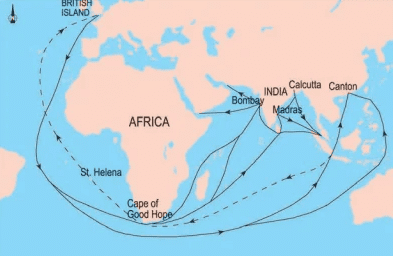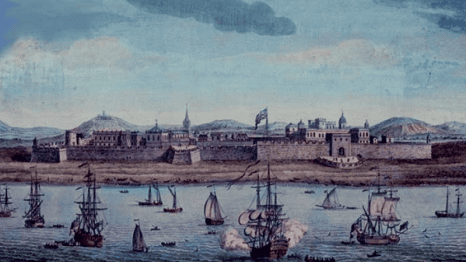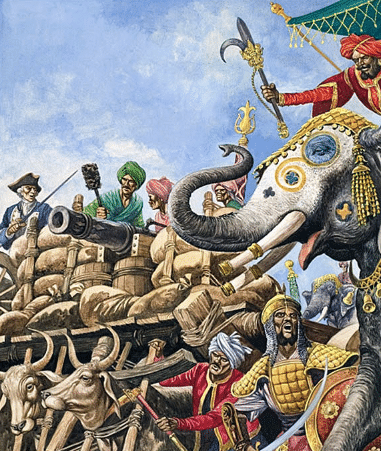UPSC Exam > UPSC Notes > History for UPSC CSE > Formation of British East India Company (December 31, 1600)
Formation of British East India Company (December 31, 1600) | History for UPSC CSE PDF Download
| Table of contents |

|
| The East India Company's Entry into India |

|
| The East India Company's Trade in Bengal |

|
| How Trade Led to Conflict |

|
| The Battle of Plassey |

|
| Aftermath of the Battle of Plassey |

|
After Aurangzeb's death in 1707, the Mughal Empire began to lose its grip on the vast Indian territories it once controlled. This decline allowed powerful regional kingdoms to emerge across India, diminishing the Mughal capital's effectiveness as a governing center. The arrival of the British, initially as a trading company, would ultimately reshape the course of Indian history.
The East India Company's Entry into India

- Royal Charter: In 1600, Queen Elizabeth I granted the East India Company exclusive rights to trade with the East.
- Monopolized Trade: With no competition from other English companies, the East India Company could explore new territories, buy goods at low prices, and sell them in Europe at a profit, without fear of rivalry from other English trading groups.
- European Rivals: However, the charter could not prevent competition from other European powers like the Portuguese, Dutch, and French, who had already established a presence in Eastern markets.
- Trade Goods: The trading companies were particularly interested in high-demand items such as fine cotton, silk, pepper, cloves, cardamom, and cinnamon.
- Competition and Conflict: Intense competition for markets often led to battles, the fortification of trading posts, and clashes with local rulers, blurring the lines between trade and politics.
The East India Company's Trade in Bengal

- First Factory in Bengal: The Company established its first English factory in 1651 on the banks of the Hugli River. This factory served as a base for the Company's traders, known as "factors."
- Expansion: As trade expanded, the factory grew into a trading center, attracting merchants and traders to settle nearby. By 1696, the Company began constructing a fort around the settlement for protection.
- Zamindari Rights: The Company secured zamindari rights over three villages, including Kalikata, which eventually developed into the city of Calcutta (modern-day Kolkata).
- Farman from Aurangzeb: The Company persuaded Mughal Emperor Aurangzeb to issue a farman (royal decree) granting them the right to trade duty-free.
- Exploitation: However, the Company’s greed for more concessions led to disputes. Although Aurangzeb's farman granted duty-free trade rights only to the Company, its officials engaged in private trade and refused to pay duties, causing significant revenue losses for Bengal.
How Trade Led to Conflict
- Regional Resistance: After Aurangzeb's death, regional powers began asserting their autonomy, and Bengal was no exception. Capable rulers like Murshid Quli Khan, Alivardi Khan, and Siraj-ud-Daulah opposed the Company's exploitation.
- Restrictions on the Company: These rulers refused to grant the Company concessions, demanded large tributes for trade rights, denied the Company the right to mint coins, and prevented them from extending their fortifications.
- Company's Defense: The Company argued that the unjust demands of local officials were ruining trade and that trade could only flourish if duties were removed.
- Escalation: In an effort to expand trade, the Company began enlarging its settlements, purchasing villages, and rebuilding forts. These actions eventually led to confrontations, culminating in the historic Battle of Plassey.
The Battle of Plassey

- Siraj-ud-Daulah’s Ascension: In 1756, Siraj-ud-Daulah became the Nawab of Bengal after the death of Alivardi Khan. The East India Company, concerned about his authority, sought to install a more pliant ruler who would grant them trade benefits.
- Failed Negotiations: The Nawab demanded that the Company cease its political interference, stop fortifying its positions, and fulfill its revenue obligations. When negotiations failed, Siraj-ud-Daulah captured the English factory at Kasimbazar and then marched on Calcutta to take control of the Company's fort.
- Company’s Response: In response, Company officials in Madras dispatched forces under Robert Clive and began prolonged negotiations with the Nawab.
- Defeat at Plassey: In 1757, Robert Clive defeated Siraj-ud-Daulah at the Battle of Plassey, largely due to the non-participation of Mir Jafar, one of Siraj-ud-Daulah's commanders, who had been promised the position of Nawab by Clive in exchange for his support.
Aftermath of the Battle of Plassey
- Mir Jafar’s Ascension: After the battle, Mir Jafar was installed as the Nawab, and the Company, preferring to focus on expanding trade rather than governing, continued to manipulate the puppet Nawabs.
- Mir Qasim’s Reign: The Company later deposed Mir Jafar and replaced him with Mir Qasim, who was eventually defeated at the Battle of Buxar in 1764, leading to Mir Jafar's reinstatement.
- Diwani Rights: In 1765, the Mughal Emperor granted the Company the Diwani rights to Bengal, allowing them to collect revenue from the province.
- Economic Impact: These rights eliminated the need for the Company to import gold and silver from Britain to purchase goods in India. Instead, the revenues were used to finance the Company’s expenses, including maintaining troops, building forts, and purchasing textiles.
Conclusion
The East India Company's initial focus on trade gradually evolved into political control. The Battle of Plassey marked a significant turning point, and the granting of Diwani rights solidified the Company’s economic and political dominance in Bengal, laying the foundation for British colonialism in India.
The document Formation of British East India Company (December 31, 1600) | History for UPSC CSE is a part of the UPSC Course History for UPSC CSE.
All you need of UPSC at this link: UPSC
|
210 videos|855 docs|219 tests
|
FAQs on Formation of British East India Company (December 31, 1600) - History for UPSC CSE
| 1. What was the significance of the formation of the British East India Company on December 31, 1600? |  |
Ans. The formation of the British East India Company marked the beginning of British involvement in trade and colonization in India and eventually led to the establishment of British rule in the subcontinent.
| 2. How did the British East India Company impact the economy of India? |  |
Ans. The British East India Company played a major role in shaping the economy of India by introducing new trading practices, exploiting resources, and establishing a system of taxation that benefitted the Company at the expense of the local population.
| 3. What were the major challenges faced by the British East India Company during its early years of operation? |  |
Ans. The British East India Company faced challenges such as competition from other European powers, resistance from local rulers, and conflicts with indigenous populations in India during its early years of operation.
| 4. How did the British East India Company eventually gain control over large parts of India? |  |
Ans. Through a combination of military conquests, alliances with local rulers, and economic exploitation, the British East India Company gradually expanded its control over large parts of India, eventually leading to the establishment of British colonial rule.
| 5. What were some of the long-term consequences of the British East India Company's presence in India? |  |
Ans. The presence of the British East India Company in India had long-term consequences such as the impoverishment of the local population, the destruction of traditional industries, the imposition of British laws and customs, and the eventual transfer of political power from the Company to the British Crown.
Related Searches















